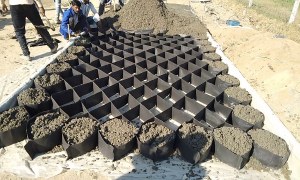🕑 Reading time: 1 minute
Properties of Lightweight Concrete
The most significant property of lightweight concrete is reduced weight at no sacrifice in strength. Structural lightweight concrete available today are rotary kiln expanded shale, clay or slate (roughly 80% of structural use) and sintered expanded shale or clay (20%). Lightweight Concrete provides the same compressive strength as normal weight aggregates with approximately the same cement content. A typical performance chart of a given aggregate shows the various strengths attainable with different amounts of cement for both 7-day and 28-day tests (Fig. 1).
Fig.1: Effect of cement content on compressive strength
Composite design, except when beams are encased, assumes no bonding action between the concrete and the steel, even though there is a considerable amount of bond under most conditions of load and building usage. The interaction between the steel and the concrete is obtained through shear connectors, and the loading on the concrete is basically that of bearing, which is directly related to concrete's compressive strength. If the lightweight concrete is comparable in compressive strength to normal weight concrete, the shear capacity (or, more correctly, the bearing capacity) of the connectors should be comparable. Pushout tests on shear connectors in lightweight concrete have indicated comparable values. However, because of some uncertainties of materials and a lack of complete test data to prove this point, many engineers and most connector manufacturers recommend some reduction in permissible load per connector when using lightweight concrete. Generally, 80% to 90% of normal weight concrete capacity is used. On the other hand, many engineers do not require any reduction in their designs. The modulus of elasticity of lightweight concrete differs from normal weight concrete. It can range from one-half to three-fourths of the E-value of normal weight concrete at a given strength level, depending on the weight of the concrete. The ACI Building Code uses this formula for estimating the E-value of both types of concrete:

